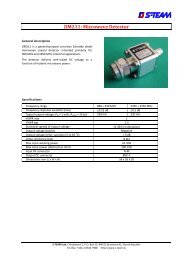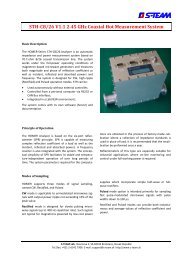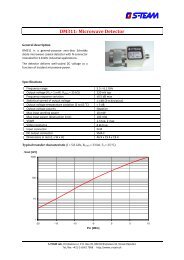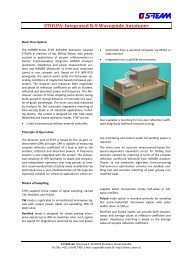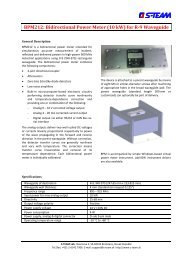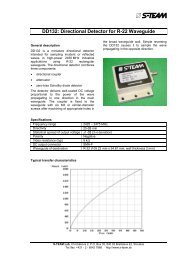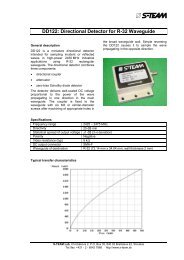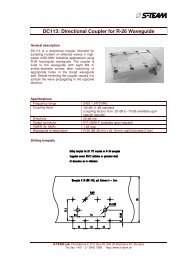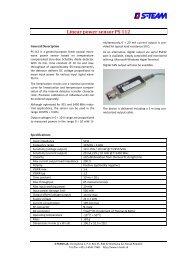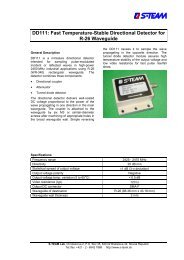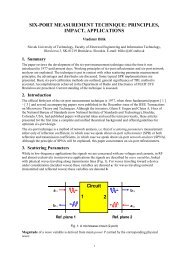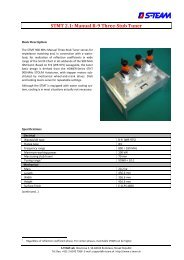Homer Hot Measurement and Tuning System - S-TEAM Lab
Homer Hot Measurement and Tuning System - S-TEAM Lab
Homer Hot Measurement and Tuning System - S-TEAM Lab
Create successful ePaper yourself
Turn your PDF publications into a flip-book with our unique Google optimized e-Paper software.
Reflection coefficient modulus<br />
M<br />
M<br />
max<br />
min<br />
M u<br />
M u<br />
The formulas assume M > u. For M < u, M min = 0.<br />
Reflection coefficient phase angle<br />
<br />
<br />
where<br />
max<br />
min<br />
<br />
<br />
<br />
180<br />
<br />
u<br />
M<br />
is phase angle uncertainty in degrees. The formula derivation assumes M >> u. Clearly, given a value of u, the phase<br />
angle uncertainty grows when the reflection coefficient magnitude decreases. For M < u, phase angle loses meaning<br />
at all.<br />
Return loss R<br />
R<br />
R<br />
max<br />
min<br />
20log(<br />
M<br />
20log(<br />
M<br />
min<br />
max<br />
)<br />
)<br />
Voltage st<strong>and</strong>ing wave ratio V<br />
V<br />
V<br />
max<br />
min<br />
(1 M<br />
(1 M<br />
max<br />
min<br />
) /(1<br />
M<br />
) /(1<br />
M<br />
max<br />
min<br />
)<br />
)<br />
Effective directivity <strong>and</strong> test port (source) match<br />
Two independent quantities usually characterize heterodyne network analyzers. These are<br />
<br />
<br />
Effective directivity E D (critical for the measurement of small reflection coefficients)<br />
Effective test port (source) match E S (affecting primarily the measurement of high reflection coefficients)<br />
In the six-port reflectometer, effective directivity can be linked with the uncertainty circle radius u as<br />
E D<br />
20logu<br />
Effective test port match cannot practically be defined.<br />
See also Deembedded Reflection Coefficient Accuracy Considerations.<br />
<strong>Measurement</strong> Uncertainty Example<br />
An example of return loss uncertainty considerations is depicted in Figure 3. If, for instance, the uncertainty radius is<br />
u = 0.02 (E D = 34 dB) <strong>and</strong> the measured return loss is 20 dB (i.e. M = 0.1), then the true value lies somewhere<br />
between R min = 18.42 dB <strong>and</strong> R max = 21.94 dB.<br />
If you wish to be sure that the true return loss is greater than 20 dB, the measured value must be so that R min is at<br />
least 20 dB. The intersection of 20-dB horizontal graticule with the lower blue line (green circle) then shows that the<br />
measured return loss must be at least 22 dB.<br />
Mathematically, R min = 20 dB corresponds to M max = 0.1. Because, as stated above, M max = M + u, the measured<br />
reflection coefficient magnitude must not exceed the value M x = M max – u = 0.1 – 0.02 = 0.08, hence the measured<br />
return loss must be at least R x = -20 log(M x ) = -20 log(0.08) = 21.94 dB, which is approximately the 22 dB obtained<br />
from the graph.<br />
User's H<strong>and</strong>book <strong>Homer</strong> <strong>Hot</strong> <strong>Measurement</strong> <strong>and</strong> <strong>Tuning</strong> <strong>System</strong> Introduction 7



